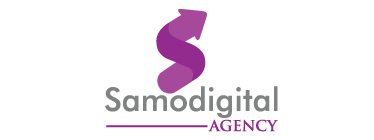
List of Top 100 Real Estate Companies in Kenya: Best Companies & Agents
Kenya's real estate space has been one of the most thriving sectors that has experienced quite substantial growth and development over the years. As an individual or investor looking for land, a home or any other real estate service, for that matter, you are likely looking for legit and reliable companies or agents in Kenya. We are here to help you find the right agent or company! In this article, we’ll review some of the top 100 real estate companies in kenya you can go for:Top 20 Real Estate Companies in Kenya
To start off let's look at the 20 best real estate companies in Kenya or rather, those companies that are popular in the market:1. Fusion Estates
Fusion Estate Management Limited (FEM), a subsidiary of Fusion Capital Limited that has been a notable player in the Kenyan real estate landscape for close to 20 years in Kenya, Uganda, and Rwanda. The Fusion Estates division of Fusion Capital primarily delivers real estate services in land acquisition, master planning, property development, and the management of Fusion's real estate portfolio. They have the best plots in Kikuyu and other parts of the Nairobi Metropolitan area.2. Knight Frank
Established in March 1998, Knight Frank Kenya operates closely with offices in Tanzania and Uganda, a regional network that solidifies the group's growing interests in Central and South Africa. Knight Frank Kenya offers a range of real estate services, including property management, agency, valuation, project management, feasibility studies, and research-led consultancy3. VAAL Real Estate
Founded in 2017, VAAL Real Estate is one of the best real estate developers with international experience, catering to buyers of luxury properties in Kenya and Africa. Yes, VAAL brings expertise in real estate development from Turkey and the Middle East. They have a presence in Kenya, Ghana, Egypt, Turkey, and the UK.4. RE/Max Kenya
RE/MAX Kenya is another top real estate company that has been in the Kenya market since 2013, although they have a global footprint with headquarters in Denver, USA. In the past 10 years or so in the market, they have managed to establish quite a robust local network of real estate agents in Kenya serving residential and commercial clients.5. AMG Realtors
AMG Realtors, is one of the premier real estate companies in Kenya with a track record of over decade in delivering exceptional services to investors seeking to buy land in Kenya. They have created a solid reputation in terms of reliability and trustworthiness locally, including Kenyans in the diaspora.6. GNA Real Estate
GNA Real Estate operates as a full-service investment and advisory firm that guides clients on their real estate strategies. The company is one of the best registered real estate agents in Nairobi that delivers insights and experience to help private and institutional clients achieve their real estate investment objectives.7. Pam Golding Properties
Pam Golding Properties Kenya has been a top real estate player in the market since 2012. They initially started with its Head Office at Fortis Tower in Westlands, Nairobi before picking up a second office at The Hub, Karen, in 2016 and a third office in the Coast Region in June 2023. They specialize in both residential and commercial real estate including sales and rental property management.8. Centum Real Estate
Centum Real Estate is one of the best national and regional real estate developers, specializing in large mixed-use projects. They are a subsidiary of Centum Investment Company which is one of the biggest companies in Kenya listed in the Nairobi Stock Exchange (NSE). They boost a list of amazing projects such as Vipingo Development in Kilifi County, Pearl Marina Estates in Entebbe, Uganda, and infill projects at Two Rivers Development in Nairobi. No wonder, Centum Re has become a prominent force in East Africa's real estate development and project finance sector!9. Impala Developers
Impala Developers Ltd is a Real Estate Company in Nairobi, Kenya focusing on ensuring appropriate land space utilization for the benefit of Kenyans. They specialize in residential and commercial properties and they have been in the Kenya & East African market for over 60 years.10 My Space Properties
My Space Properties is a real estate and property known for property listings that has a diverse range of homes available for sale or rent. The listing website features new house and land packages, apartments, and land estates in its dedicated new homes section, showcasing the latest designs in the market. The services provided by My Space are designed to meet the growing demands of the real estate sector in Kenya, with a specific focus on Mombasa and the Coast region.11. Saif Properties
Saif Real Estate is another one of the leading property developers in the East African region with extensive expertise and track record in the market. They provide innovative, luxurious, and high-quality housing infrastructure with tailored payment plans12. Username Investment Limited
Username Investment Limited stands as one of the fastest growing real estate development and investment companies specializing in selling land from as low as Ksh. 250,000. They are one of the best land selling companies in Kenya selling affordable plots in areas like Nakuru, Juja, Kisumu, Kangundo Road, Ngong, Konza, Tinga, Naivasha, Ipolosat, Matuu, and Athi River.13. Dunhill Consulting
Established in 2003, Dunhill Consulting Limited is a property management consulting firm that offers property services ranging from management, sales, lettings, and consulting services.14. Halifax Estate Agency Ltd
Halifax Estate Agency Ltd is a property management firm founded in the late 1990. For over 30 years now, the company has carved its niche as one of the top real estate agencies in Nairobi.15. Eden Heights Reality
Eden Heights stands out as one of the best real estate companies in Nairobi, Kenya, thanks to a blend of hands-on experience, professional networks, and a personal touch to their customer experience. They focus primarily on sales and rentals, property management, valuation, and interior building works.16. Ryden International
Ryden International's success was founded way back in 1996 and it has grown to become one of Kenya's most respected estate agency firms. The founder Iain Illingworth initially worked for 31 years as a Chartered Surveyor before relocating to Kenya to set up the firm. As the Managing Director from 2000 to July 2015, Iain Illingworth led the company through a period of significant expansion, overseeing property valuations across East Africa,including farms, commercial, and residential properties. Under his guidance, the real estate agency function of the firm experienced substantial growth into one of the top respected estate agency firms in Kenya17. Hass Consult Real Estate
Hass Consult is one of the leading real estate firms that pretty much shaped the industry by introducing transparency, integrity, and professionalism to the Kenyan real estate landscape. They have etched out a name when it comes to services like Joint Venture & Finance Structuring, Development Concept & Design Alignment, Development Marketing & Sales, Property Sales & Letting, Valuations, Property & Facilities Management and Property & Market Research18. Coral Property International
Incorporated in Kenya in September 2012, Coral Property International aimed to create a niche in the realty market by providing discerning clients with properties from Kenya, East Africa, the United Kingdom, India, and the Middle East. Today, the company has firmly established its presence in the Kenyan real estate industry, offering a wide scope of real estate services and consultancy to individuals and businesses in the region.19. Tyson Limited
Tysons Limited is one of the best real estate companies in Kenya founded in 1923. The company specializes in the valuation of land, buildings, machinery, and other assets to clients in Kenya, Uganda, Tanzania, Ethiopia, Seychelles, and West Africa.20. Alliance Realtors
Alliance Realtors is one of the leading real estate companies that offers professional estate management services including management of commercial and residential properties. The firm also offers property and asset valuation, property sales & letting services to property owners.Other Top Real Estate Companies in Kenya
Here are more companies to complete the top 100 real estate companies in kenya:- Koch Properties
- Peponi Real Estate
- Commercial Property Kenya
- Valuablehomes.co.ke
- Kenyaproperty centre
- UIP Real Estate
- Fanaka
- Kenya Valuers
- Premier Reality
- Legacy Estates
- Premier Agent
- Almond Estate
- Estate Center
- Masterways Real Estate
- Icon Valuers
- Certified Homes
- Novaprime
- Homs Group International
- Think Real Estate
- Good Home Mortgage
- Superior Homes Kenya
- Euro Trust Real Estate Agency
- Proxima Real Estate
- Regent Management
- Lloyd Masika
- Comfort Homes
- Wazury Real Estate Ltd
- Amref Sacco Housing
- Lesedi Developers
- Villa Care Kenya
- Elegant Properties
- Integrum
- Madonna Realtors
- Sir Francis Marketing & Consultants
- Mhasibu Sacco
- Mahiga Homes
- Square Foot Real Estate
- Optiven
- Lesama
- Tsavo Real Estate
- Rama Homes Ltd
- NawiriLand
- SandLovers
- Kimisitu Investments
- Coast Properties
- Dyakio
- Estate Intel
- Kings Developers
- Solian
- MilikiSpace
- Revohouse Ltd.
- Karen Gata Property Managers
- Dahna Properties
- kenya Homes
- Hyssop Properties
- Residence Real Estate Mombasa
- DK Real Estate
- Rubyland
- Valiant Real Estate
- Miliki Properties
- Almasi Land Merchants
- Kulta Properties
- Dahari Developers
- Coral Property Consultants
- Paul and Group
- Ndatani
- Pinnacle Valuers
- Enkavilla
- Amcco Properties
- NW Realite
- Olympia Gold
- West Kenya Real Estate
- Willstone Homes Limited
- Lavender Properties Limited
- Azizi Realtors
- Real Appraisal Ltd
- Goshen Real Estate
- Best Link Developers Ltd
- Amara Realty Company Limited
- Pro Property Ltd

Best SEO For Law Firms Tips: 9 Ways to Improve SEO for Law Firms Website
How can I improve my SEO law firm website?
When people search for something on Google, they are more likely to click on the results that appear at the top of the page. Therefore, it is important to for any business to rank high including your law firm in Kenya. How will you achieve this? Search Engine Optimization (SEO) plays a pivotal role in ensuring that your law firm's website ranks well in search engine results and attracts potential clients. With countless law firms in Kenya vying for online visibility, it's crucial to employ effective SEO strategies to stand out from the competition. In this article, we will explore some key steps to improve the SEO of your law firm website and be more discoverableWhat is SEO for law firms?
SEO for law firms is the process of optimizing your law firm's website and online content to rank higher in search engine results pages (SERPs). This helps potential clients find your website when they search for legal services related to your practice areas.Why is local SEO important for law firms?
Local SEO is important for law firms because it helps them attract potential clients who are looking for legal services in their area. When people search for a lawyer online, they are often looking for someone who they can meet with in person. Local SEO helps law firms rank higher in search results for local keywords, such as "lawyer near me" or "divorce lawyer in Kenya" or "commercial lawyer in Nairobi"Here are some of the specific benefits of local SEO for law firms:
- Increased visibility: Local SEO helps law firms show up in the local search results, which is where many potential clients start their search for legal services.
- Targeted traffic: Local SEO helps law firms attract visitors who are more likely to become clients, because they are looking for legal services in the firm's area.
- Improved credibility: Local SEO can help law firms build credibility and trust with potential clients, because it shows that the firm is active and engaged in the community.
- Higher conversion rates: Law firms with a strong local SEO presence tend to have higher conversion rates, meaning that more visitors to their website turn into clients.
How to Improve Your SEO for a Law Firm Website
1. Have a User Friend Website
To start with you need to have a website for your law firm and not just a website but a user friendly website. A user-friendly website not only improves SEO but also encourages potential clients to easily engage with your firm services. Ensure your website is easy to navigate, has clear calls-to-action (CTAs) and links are clickable. The easier it is for users to find information, the longer they are likely to stay on your website. If you don’t have a website, you can either hire best web designer in Kenya or use a content management system (CMS) like WordPress or Wix to create your own website2. Do Keyword Research
Start your SEO journey with thorough keyword research. Identify relevant keywords and phrases that potential clients might use when searching for legal services. You can use tools like Google Keyword Planner, Ubersuggest, Ahrefs or Keyword Tool that can help you discover high-value keywords. Incorporate these keywords naturally into your website's content, including blog posts, practice area descriptions, and meta tags.3. Create High-Quality Content
Content is king in the world of SEO! You cannot rank high on search engines without content. Therefore, you need to create informative and engaging content that addresses the legal needs and questions of your target audience. You need to use keywords that are related to legal issues to generate content for your blog. For instance, if you are divorce lawyer, some of the topics that are most searched in Kenya are- Divorce lawyers near me
- How much does a divorce lawyer cost in Kenya?
- How much does it cost to file a divorce case in Kenya?
- family lawyers near me
4. Mobile Optimization
How does your website behave when viewed on a mobile device? Google puts great emphasis on mobile-friendliness when ranking websites. Ensure that your law firm website is responsive and optimized for mobile devices. A mobile-friendly website not only provides a better user experience but also boosts your SEO rankings. You can run a mobile friendly test for your website and improve it5. Page Speed Optimization
Page speed is another crucial factor in SEO. Slow-loading websites frustrate users and can lead to a high bounce rate. Incfact, statistics show that 83% of people expect a website to load in 3 seconds or less. Use tools like Google's PageSpeed Insights to identify and rectify issues that may be slowing down your site. You also need to optimize pages that you upload. Compress images, leverage browser caching, and minimize unnecessary scripts to improve load times. You can install relevant plugins to make your work easier.6. Local SEO
Law firms often serve specific geographic areas for instance, Nairobi, Kisumu or Mombasa or Kenya. The goal then is to attract local clients, optimize your website for local search. One way to do so is to claim and complete your Google My Business profile. Statistics show that 46% of all Google searches are looking for local information. Therefore, ensure that your firm's business name, address, and phone number are consistent across all online directories. Encourage clients to leave reviews, which can significantly impact your local search rankings. In your descriptions, also use local keywords and remember to add social media profiles to Google My Business.7. Link Building
Link building is the process of getting other websites to link to your website. It is one of the most important factors in search engine optimization, as it helps to improve your website's authority and ranking in search results. You need to create good quality content to build high-quality backlinks from authoritative legal websites, directories, and local blogs. Guest posting, partnerships, and participating in legal spaces and events can help you earn valuable backlinks that boost your website's authority.8. On-Page SEO for Law Firm
Another way to improve SEO for your law firm is doing on-page optimization. Optimize your website's on-page elements, such as title tags, meta descriptions, and header tags. These elements should contain your targeted keywords and provide clear and concise information about your services. Having well-structured content with proper headings not only helps with SEO but also enhances readability for people seeking services at your law firm9. Regular Analytics and Monitoring
Once all the essential SEO for a Law firm is implemented, you need to regularly monitor your website's performance. Use tools like Google Analytics and Google Search Console. Analyze user behavior, track keyword rankings, and identify areas for improvement. Use this data to refine your SEO strategy and stay ahead of the competition.Conclusion
Improving your law firm website's SEO is an ongoing process that requires dedication and continuous effort. Implementing on page and off page optimization will enhance your online visibility, attract more potential clients, and ultimately grow your legal practice. Also, SEO is a dynamic field, so staying informed about the latest trends and algorithm updates is key to long-term success in the digital landscape. If you need help with writing monthly blogs and optimizing your law firm website in Kenya, contact us at Samodigital agency at info@samodigitalagency.com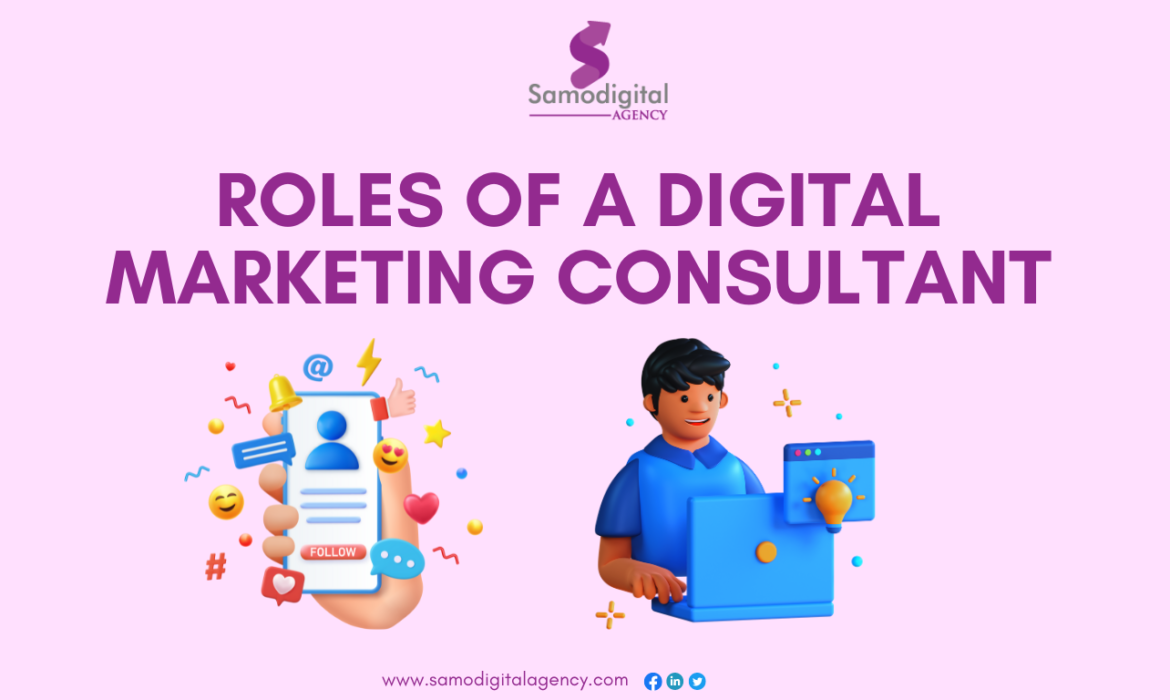
7 Essential Qualities of a Successful Digital Marketing Consultant
What does digital marketing consultant do?
In todays’ ever changing world, you may need to work with a digital marketing consultant to elevate the growth of your business. What does a digital marketing consultant do? A digital marketing consultant is a professional who helps businesses and organizations develop and execute effective digital marketing strategies. They provide expert advice and guidance on various aspects of digital marketing. This will help you achieve their marketing goals and increase their online presence. Here are some key responsibilities of a digital marketing consultant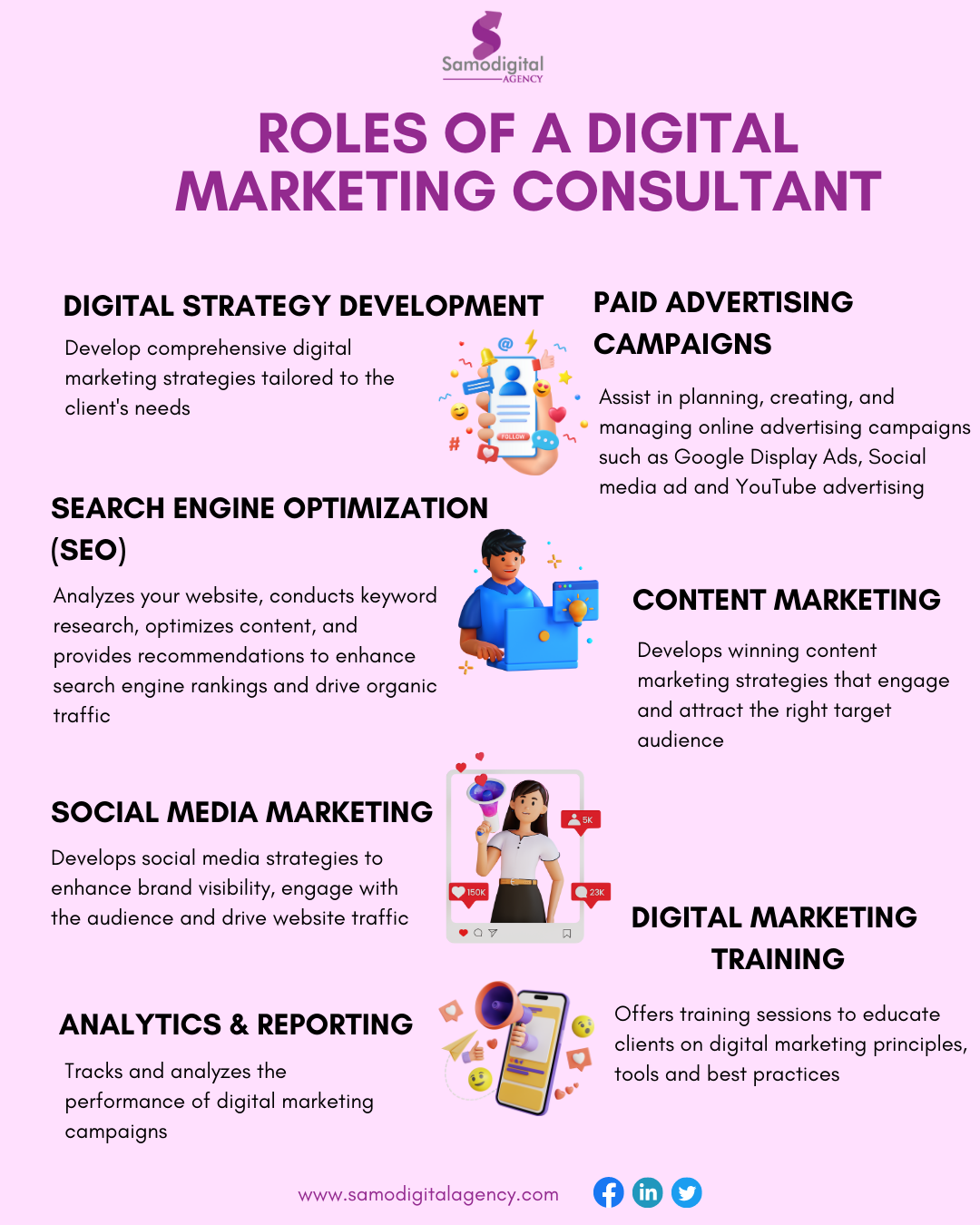
Roles of a digital marketing consultant Samodigital Agency
1. Digital Strategy Development
A consultant collaborates with clients to understand their business objectives and target audience and ideal social media platforms. They develop comprehensive digital marketing strategies tailored to the client's needs. This involves identifying the most suitable digital channels and tactics to reach the target audience effectively.2. Run Paid Advertising Campaigns
Hiring a digital marketing consultant will assist you in planning, creating, and managing online advertising campaigns across platforms such as Google Ads, social media platforms, and YouTube advertising. They will help you optimize campaigns to achieve maximum reach, engagement, and conversions within the allocated budget.3. Search Engine Optimization (SEO)
As you know, SEO is crucial for improving a website's visibility in search engine results. You will not be able to execute this alone if you don’t know how to do it. That's why you will need an experienced digital marketing consultant. A digital marketing consultant will help you analyze websites, conduct keyword research, optimize content, and provide recommendations to enhance search engine rankings and drive organic traffic Click To Tweet. Some will even be able to write engaging and informative content for your website.4. Content Marketing
Content is King! It’s what drives engagement, leads and conversion for any business. A consultant will also help you develop winning content marketing strategies that engage and attract the right target audience. You can read this article to understand types of content and why it’s important to brands. Consultants often assess the performance of content and make suggestions for improvement.5. Social Media Marketing
Moreover, consultants assist in developing social media strategies to enhance brand visibility, engage with the audience, and drive website traffic. Right now, we have top social media platforms and emerging platforms. Platforms like Threads, Lemon8, Bluesky and much more to come. Therefore a consultant will recommend platforms suitable for your business, create content calendars, and provide insights. Also, they will optimize social media posts and advertising to ensure you gain the most from your marketing efforts and return investment.6. Analytics and Reporting
With digital marketing you can easily track and measure your marketing efforts. To add on, working with a consultant will help you use various tools to track and analyze the performance of digital marketing campaigns. These could be web analytics tools like Google Analytics, In-app social media analytics or third party analytics tools like Semrush, Sprout Social among others. Moreover, They will provide you with reports while highlighting key metrics, trends, and areas for improvement. Consultants use these insights to refine strategies and make data-driven decisions.7. Digital Marketing Training
Finally, some consultants may offer training sessions to educate clients on digital marketing principles, tools, and best practices.If you are in Kenya and you would like to have in-house training for your team, you can hire a certified digital marketer like Egline Samoei Click To Tweet. She will help you gain a better understanding of digital marketing and empowers them to execute strategies independently if desired. Yo can reach out via email at egline@samodigitalagency.comIn Conclusion
To conclude a digital marketing consultant helps businesses leverage digital channels effectively to achieve their marketing objectives, improve brand awareness, drive website traffic, and generate leads or sales. Lastly, they stay updated with the latest trends and technologies in the digital marketing landscape to provide valuable insights and guidance to their clients.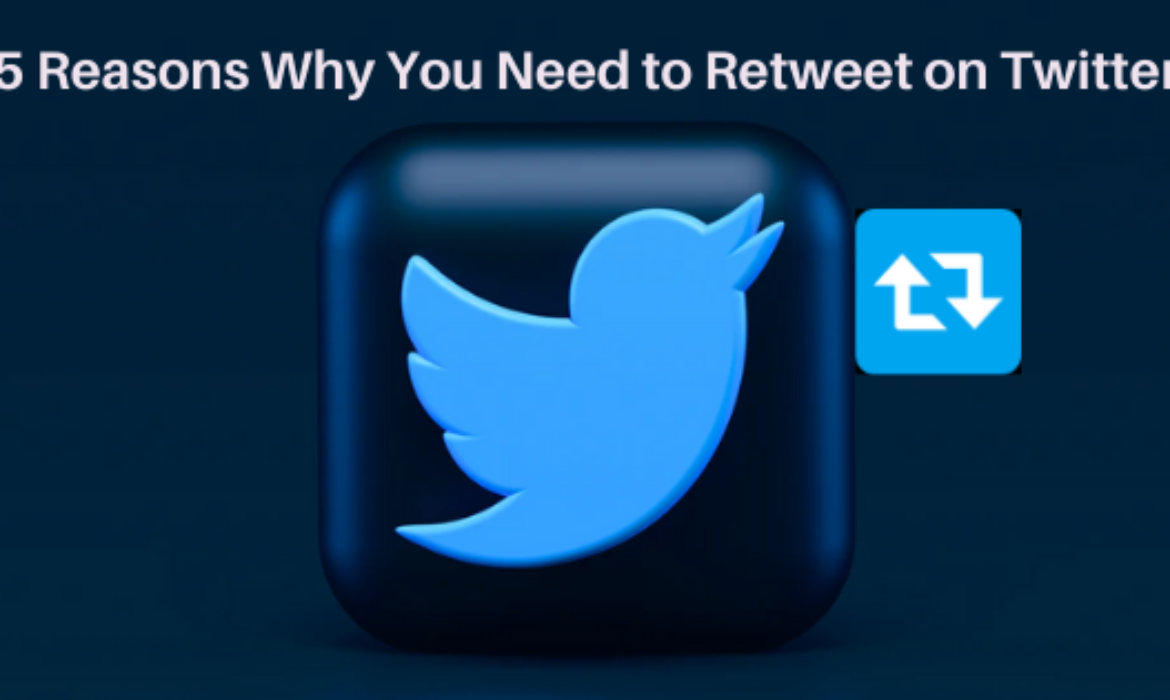
Quote Tweet vs. Retweet? 5 Reasons Why You Need Retweet Posts
The engagement metrics on Twitter are retweets, quote retweets, likes, link clicks and impressions. However, retweeting is viewed as an important metric on Twitter, not just for a marketing campaign but even for Tweep(user). In this article we look at the difference between a retweet, a quote tweet and then look at the importance of retweeting a post. Let us get started!What is a retweet?
Twitter defines a retweet as a re-post of a Tweet. The Retweet feature helps you and others quickly share that Tweet with all of your followers. You can Retweet your own Tweets or Tweets from someone else. Some users disagree with Retweeting your own Tweets and even made hilarious Tweets About Retweeting Your Own Tweets, but you have heard from the horse's mouth; You can retweet your own tweet!What is a Quote tweet?
On Twitter, you can retweet or quote a tweet. When you quote a tweet, you are retweeting a tweet and adding your comments. It could be a recent Tweet post that you want to add your perspective or an old post that is relevant again. Twitter introduced Quote Tweets in 2020 as temporary tweet format ahead of the November 3rd US presidential election, to help prevent abuse and the spread of misinformation.In both cases you just retweeting but quote retweet you can add your comment.Tweets about a Tweet add more to the conversation, so we’ve made them even easier to find.
Retweets with comments are now called Quote Tweets and they've joined the Tweet detail view. Tap into a Tweet, then tap "Quote Tweets" to see them all in one place. pic.twitter.com/kMqea6AC80 — Twitter Support (@TwitterSupport) August 31, 2020
Why Do You Retweet on Twitter?
So why do we retweet? Now that we have distinguished between the two types of retweets available on Twitter, you need to know the importance of retweeting.1. To quickly share information
Many will agree that they retweet as a quick way to share information while attributing it to the source. Assuming trusted source posts a piece of breaking news, you will likely retweet the post instead of creating a new one of the same content. The news could be about a winner of an event, say the Tokyo Olympics, the death of a popular figure, natural calamities, court ruling or any other news. Below is a poll I conducted on the reasons why people retweet.Hey Tweeps, why do you retweet a Tweet?
— Egline Samoei (@EguarEglin) July 9, 2021
2. To amplify information
People also retweet tweets so that they can amplify the information to their followers. Also, it is a means of sharing information, but this time, it reaches a new audience or your audience. Assuming there is a post by Samodigital Agency on tips on content creation, I would retweet the post so that it can reach many people interested in the marketing tips.3. To add your perspective
You may come across a post that you may want to add your sentiments different from the sources. In this case, you will quote a tweet with your sentiments. If an old tweet has become relevant again, you can retweet it and quote with the current context. You can also quote a tweet poll to give the results or a finding of a poll. Here is a good scenario by social media marketing strategist and Founder of Africa Tweet Chat Janet MachukaWow! According to this poll, most people can comfortably quit Instagram.
Once crazy response was, "I don't have clothes for Instagram." Well, please wear that one dress all the time. https://t.co/cpHqagVVdV pic.twitter.com/NfKiTsonSu — Janet Machuka (@janetmachuka_) September 7, 2021
4. To make one's presence as a listener visible
You can also show support to a person on Twitter by retweeting their post and making them visible. Mark Trammell, a design researcher at Twitter, says, "People also retweet to introduce their followers to someone new or to shine a spotlight on someone deserving…The retweeter becomes the person who brings the new cool kid in town to the party."5. Build relationships
When you retweet a person's tweet, you are not only sharing information or amplifying their tweet but also building relationships. Yes, that is how online relationships are built and nurtured. You may have come across a situation where a person retweets your tweet, and you go ahead and check their profile and even follow them. With time you get to build meaningful connections.Wrapping Up
Engagements on Twitter vary but retweeting a tweet is seen to be more powerful. It is an easier way to share and amplify information. It also gives you a chance to gain followers and attract relevant personalities. Keep tweeting, keep retweeting. Eventually, build and grow your network! Follow Egline Samoei Twitter and LinkedIn as well as Samodigital Agency on LinkedIn and Twitter for more engagements.7 Privacy and Safety Tips on Social Media during Covid-19 Pandemic
Have you ever thought of your safety on social media? What content are you sharing online? Who are your friends or followers? The use of social media platforms is on the rise. Covid1-19 has even accelerated social media usage as a means of communication since most people are working from home. People are using social media for different reasons. According to the Global Web Index report, the following are the top reasons why people are using social media during the Covid-19 pandemic are to:- Stay up to date with current news and update
- Fill up spare time
- Find funny or engaging content
- Keep in touch with what friends are doing.
1. Use Strong Passwords
For your social media accounts to be more protected, use strong passwords. Your passwords should entail letters, special characters, numbers and make it at least 8 characters. For your social media accounts to be more protected, use strong passwords. Your passwords should entail letters, special characters, numbers and make it at least 8 characters. Click To TweetMoreover, be creative with your passwords. Do not use your names, place of birth, parents' name, your school, which are passwords that malicious people can easily guess. Other tips related to passwords for you are:- Use different passwords for different social media accounts
- Do not share your passwords with anyone
- Use two-factor authentication that adds an extra layer of authentication
- Set up security questions
2. Familiarize Yourself with Privacy Settings for Each Platform
Each social media platform has privacy settings that allow you to control or customize your privacy settings. You can control what should be visible to your connection, what people can share, your social media activities or manage how a social media platform uses your data. You can also choose to keep your social media account private or visible to everyone. Have a look at the privacy settings of LinkedIn on what you can control.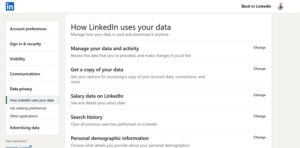
LinkedIn privacy settings
3. Be Selective on Friend Requests
Be selective on friend requests and do not accept friend requests of people that you don't know. The friend request you could accept could be a fake account or a malicious person who wants to get hold of the information you share online. Be selective on friend requests and do not accept friend requests of people that you don't know. The friend request you could accept could be a fake account or a malicious person who wants to get hold of the information you share… Click To TweetMoreover, do not shy away from cleaning your friends list or connection. Last year, I noticed that I had many friends on my Facebook account that I didn't even know that I had accepted in the past. I took the initiative of unfriending strange people just to secure my account. Remember, you have the power to control the people whom you want to be your friend online and never feel guilty about rejecting some friend requests. Also Read: A Look at Social Media Universe in 20204. Be Cautious of What you Share
"Don't say anything online that you wouldn't want to be plastered on a billboard with your face (or logo) on it."-Erin Bury Don't say anything online that you wouldn't want to be plastered on a billboard with your face (or logo) on it. Erin Bury Click To Tweet As you type on "What is on Your Mind" on Facebook, "What do you want to talk about" on LinkedIn or "What is Happening on Twitter," remember what happens on social media stays on Google forever. You may delete what you have posted but remember somebody might have taken a screenshot of it and saved it. So be careful before you hit that "Post" button. To add on, be calm on what you post or share on social media. Do not share everything and anything going on in your life on social media. From what share, say a location malicious person can take advantage of that information and even come to where you are. Also, do not share sensitive information like your phone number, bank details, passwords, date of birth, account numbers on social media that hackers can use against you. When you have a complaint that you are raising to a company through their social media platform, learn to inbox them your personal details rather than posting the complaint with your personal details on their wall.Don't share sensitive information like your phone number, bank details, passwords, account numbers on social media that hackers can use against you. When you have a complaint that you are raising to a company through their social media… Click To Tweet Hackers and malicious will take advantage of that information.5. Avoid signing Up on third-party apps with your social media credentials
You must have come across sites or apps that allow you to sign up using your social media accounts or email. Avoid signing up on third-party apps using your social media accounts because you will be granting those sites more information about you.6. Avoid Playing Online Games and Quizzes
The most relatable games and quizzes are those fun games on Facebook like Nametests and Meaww. You may or may not have participated in those quizzes and names, but from today avoid participating in those games if you care about your personal security and privacy. All those clicks and taps give the Quiz company information on you. Avoid participating on social media games if you care about your personal security and privacy. All those clicks and taps give the Quiz company information on you. Click To Tweet If you check the privacy terms of Nametests, an Instant game website available on Facebook, they say they process user's data such as name and profile picture. "When users create a user account with us, we store so-called inventory data, such as the first names of users or app-scoped IDs ("player ID"). Depending on which of our Online Services, our users use, other data, such as profile pictures or text entries may also be processed. We also process data on the use of our services, such as contents that have been viewed, times of use, their duration and technical details, such as browsers or devices used, in order to make our offer user-friendly and secure." Therefore, if you are mindful of your online data and don't want to share with third-party apps like this quiz site, stop participating in those games. Also Read: 8 Effective Habits for Quality SaaS Content Writing7. Learn to Logout from Public Computers
To wind up, if you must use a public computer or device to log in to your social media account, learn to log out from those devices. Failing to logout from the public device, a person who will use it after you will definitely be gaining access to your social media account and your personal information, which is not good. For personal computers, ensure that you install antivirus software to protect your computer.Wrap Up
To conclude, observing the above social media tips ensures your personal data safety and your safety on social media. If you need a technical writer who can write similar topics on security, the Internet and social media, kindly feel free to shoot an email on egline@samodigitalagency.com. For more topics on content marketing, kindly check out Samodigital Agency blog
SaaS Content Marketing: 8 Effective Habits for Quality Content
Why Quality Content?
"Google only loves you when everyone else loves you first." – Wendy Pier.Google only loves you when everyone else loves you first. Click To Tweet To rank on Google's top page, you should create content that is in line with Google's Algorithm. It is not just about ranking top on the Google search engine but creating authentic and valuable content for your target audience "Google wants to reward high-quality sites that contain original content. So not only does great content make a better website, but it also improves your site's rankings, which can have a very positive impact on your business.t that is useful to your audience." Says Neil Patel, the co-founder of Crazy Egg, Hello Bar and KISSmetrics. Therefore, there is a need to create quality content for your website or blog post. Now, let us look at habits you need to have to create quality content for any SaaS tool1. Have a SaaS Content Marketing Strategy
Having a strategy is a key ingredient in producing quality content. Set out your goals, establish KPIs, profile your target audience, choose content type, and determine how you will measure the results. As a content marketing team, ensure that you meet weekly or daily to discuss your content marketing strategy. The meetings have proven to be yield good results for content marketing. According to the B2B content marketing report, effectiveness is greater among teams that meet more frequently (61% of the most effective B2B marketers meet daily or weekly). With the Covid-19 pandemic forcing organizations to work remotely, you can still have meetings virtually via video conferencing tools like Zoom, Google Hangouts, Skype, etc. If you are a sole content marketer, you still need to evaluate your content marketing strategies and plan.2. Create Original Content
Always create original content that resonates well with your brand audience. Google does not like plagiarized content, and you will be punished for that. As a matter of fact, there many contents out there that you can reference but do not copy and paste the content to your website.3. Update Your Content
Effective SaaS content marketing is not always about creating new content only. It is also about updating the existing articles, How-to topics, blog posts or any content on your website. Google Search Console is a great platform to give you clues on what you need to update on your existing articles. You will find new search terms that will enable you to add or remove from your existent article. Take, for example, if you are into the SaaS industry and your company has added a new feature that is useful during the Covid-19 pandemic or software user interface has been updated. You have articles written base on the old interface. Is it not time to update them?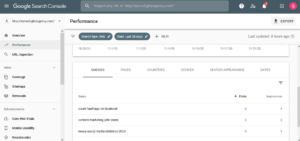
Google Search Console Queries
4. Your Content Should Provide Answers
When writing SaaS content, write content that provides solutions to your readers or clients. Write educational content and avoid promotional content. When writing SaaS content, write content that provides solutions to your readers or clients. Write educational content and avoid promotional content Click To Tweet A person clicks on a link to your article because they know the article will provide an answer to what they have queried on the search engine. Neil Patel adds by saying that "people don't just want answers, they want answers fast. So, make your content easy to scan so people can pick up the juicy, important bits quickly."5. Monitor Brand Mentions
There are plenty of reasons why you need to track your brand mentions online. An online user can review your product or service and they fail to link back to your site. In this case, you will have a great reason to reach them out and request them to link back. On the other hand, if it is a negative review, you will reach out to them and handle the situation before it gets worse. Use tools like Google Alerts, Brand24, Brandmentions, Semrush Branding monitoring, among others, to monitor your brand online.Use tools like Google Alerts, Brand24, Brandmentions and Semrush Branding monitoring tool to monitor your brand online. Click To Tweet6. Incorporate Images and Videos
The best way customers can learn and feel about your product or service is by adding images and videos to your website content. Using the visuals graphics illustrates the point you are making clearly. For instance, you are writing an article on installing or using your app or software. Using images for each step provides the reader with a clear step on what they need to do.7. Share your Content
After writing your content or creating those beautiful infographics, you need to share them with your communities. Publish the content on your blog, share the content on social media and forums like Quora. Sharing content creates engagement, brand awareness, generates a lead, increases sales, and leads to upselling or cross-selling. With that in mind, always add a call to action in your articles.8. Monitor and Evaluate your Content Performance
Now, you have created your content, published it and shared it with your community. What next? What follows is for you to monitor and track the performance of your content. A good web monitoring tool you can use is Google analytics. It well helps you monitor your website activities such as real-time traffic, pages per session, bounce rate, traffic channels, user's behaviour and devices they use etc.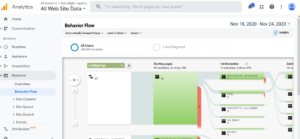
Google Analytics interface
Wrap Up
Quality and creativity are key to SaaS content marketing that you can infuse into your overall digital marketing strategy. When creating content, always provide value to your customers and be simple and straightforward. Keep updating your content, and remember to evaluate your content performance. In an event where you want a SaaS content writer or tech writer to write articles, blog posts, guest posts, press release or editorials, Samodigital Agency can do that for you. Send an email at egline@samodigitalagency.com. You can also follow Egline on LinkedIn and Twitter.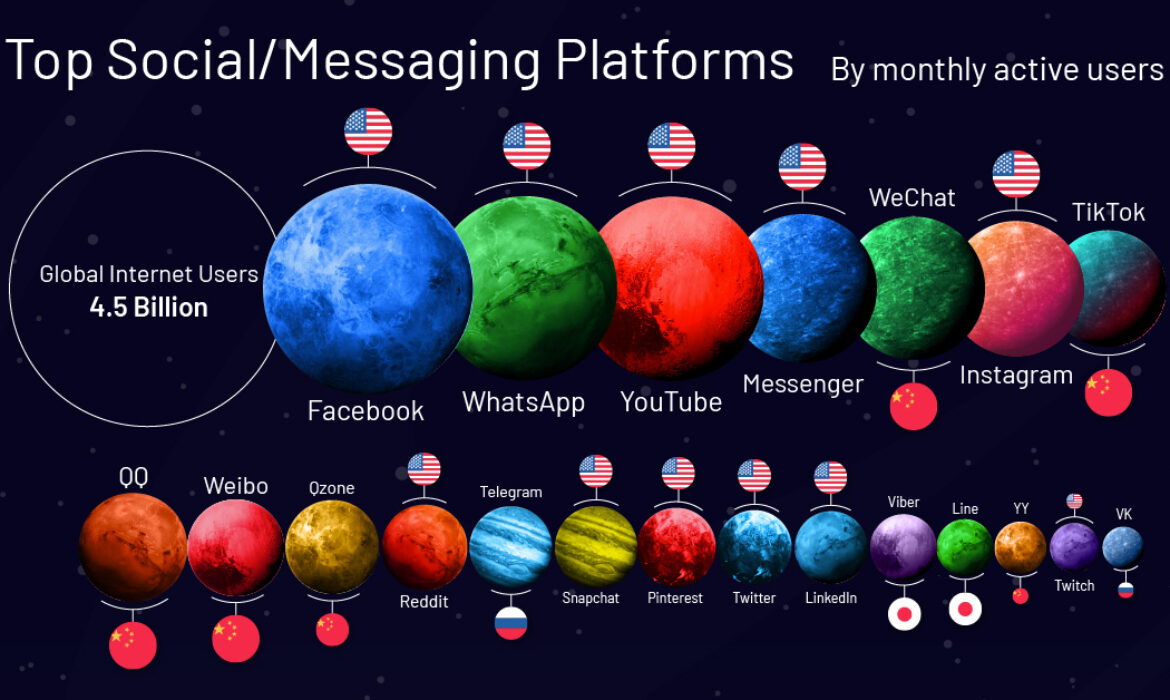
Here is a Look at Social Media Universe in 2020
Imagine the social media world as a universe and social media platforms as the planets? How many social media platforms will that be in that universe today? Well, that is how Visual capitalist has visualized the Social Media Universe in a fantastic infographic. Today, there are many social media platforms, and they keep evolving year by year. In 2020 we saw the rise of the Chinese Byte dance TikTok TikTok cross 2 billion downloads globally, more than any app ever on the App Store and Google Play. Moreover, the Covid-19 Pandemic has steered more engagements to social media platforms than ever before. When Visual Capitalists posted the social media universe infographic, they reported that there were 3.8 billion social media users worldwide, representing 50% of the global population. Note that, Globally, 4.5 billion people use the Internet. The infographic also visualizes Monthly Active Users (MAU) of each social media platform. The top 5 social media platforms are Facebook, WhatsApp, YouTube, Messenger, and WeChat.Here is a look at the Social Media Universe in 2020
This social media universe has been clustered to different categories. They include Zuckerberg cluster, Asian Cluster Tencent Cluster and Rakuten Cluster.
Social Media Universe 2020 by Visual Capitalist
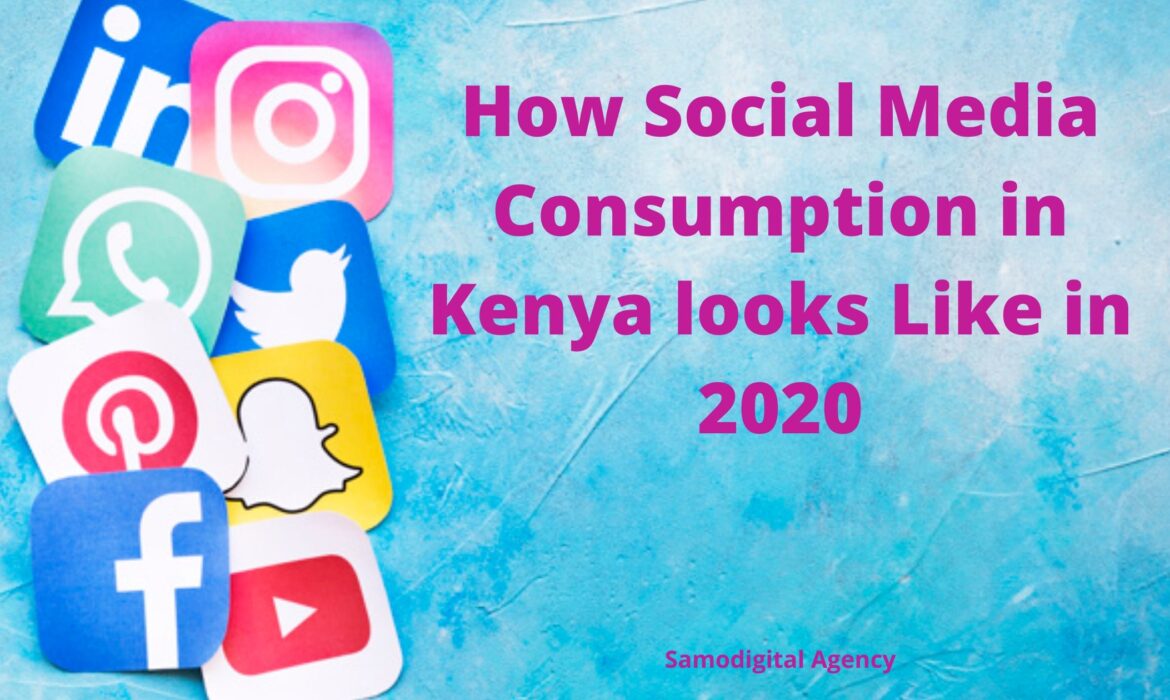
How Social Media Consumption in Kenya looks Like in 2020
Kenya Social Media Statistics 2020 Social Media Usage in Kenya
How is social media consumption in Kenya in 2020?
If you are living it in this era, you must have used any form of social media, if not a majority of social media platforms. They are different social media platforms across the globe, with some that keep emerging. In Kenya, where there is an increase in internet connectivity and usage in mobile devices, we have seen brands and individuals use social media to interact and build online communities, among others. But how are Kenyans using social media in 2020? In this article, we look at social media consumption in Kenya in 2020.
What is Social Media?
Before we look at the social media statistics in Kenya in 2020, we must first define the term
social media. Social media can be plainly defined as tools or platforms that are internet-based that enables you to connect, communicate, interact, and share content instantly and efficiently. Some of the popular social media platforms include Facebook, Instagram, WhatsApp, TikTok, Twitter, Snapchat, YouTube, Pinterest, LinkedIn, to mention a few. Each social media has different usage and set of rules. In our next article we look at How Kenyans are Using Social Media. Keep checking on our blog for the next article.
What is the Average Daily time spent on Social Media?
The Global Webindex social media report shows that globally, digital consumers are now spending an average of 2 hours and 24 minutes per day on social networks and messaging apps. Now, narrowing it down to Kenya, the
SIMElab report shows that a vast majority ofKenyans spend more than 1 hour per day on social media. Click To Tweet
.
At What Time Do Kenyans Spend Time on Social Media the Most?
A majority of Kenyans spend more time on social media at night and the evening with the least hours being in the morning. Click To Tweet This data is crucial for you as a brand so that you can know when it is the best time to post your content on social media.
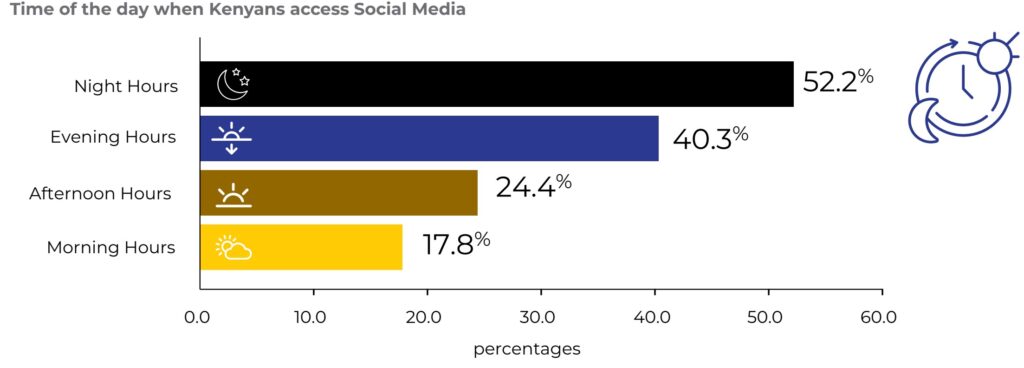
Times when Kenyans spend most time on social media 2020. Source: SIMElab report 2020
Also Read: India Bans 59 Chinese Apps including TikTok, UC Browser and ShareIT
An Overview of Top 7 Social Media Consumption in Kenya in 2020
According to the Kenya Social Media Landscape report, 2020 by USIU University SIMElab, the WhatsApp, Facebook, and YouTube are the most used social media platforms in Kenya.
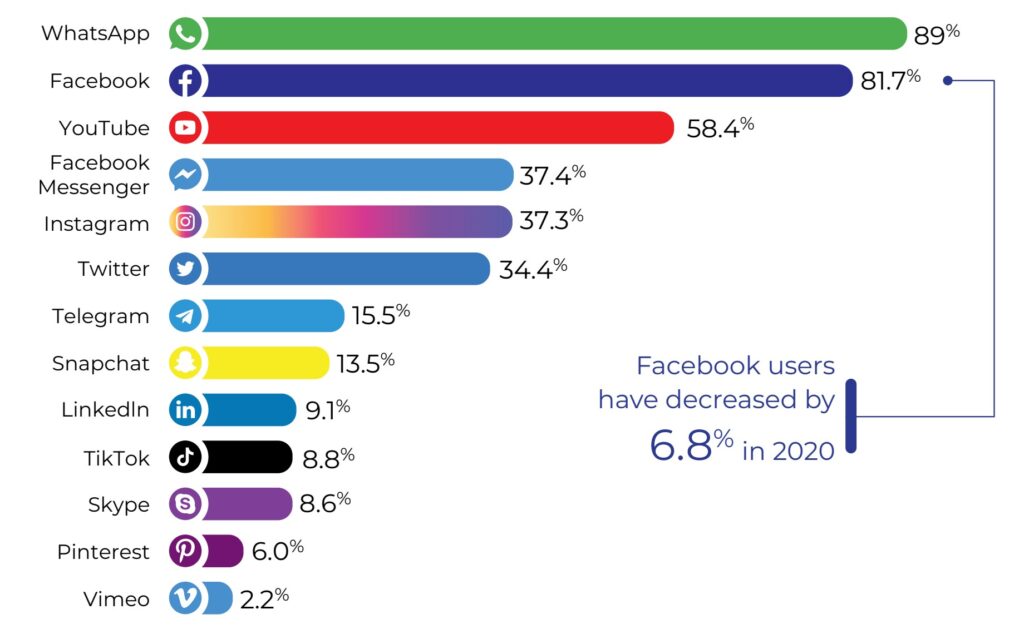
Social media consumption in Kenya 2020. Source: SIMElab report
1. WhatsApp
The report shows that the most used social media in Kenya is WhatsApp. WhatsApp users in
Kenya amount to 89%, and it is most popular among people above 45 years. 54.5 percent of Male use WhatsApp compared to 45.4 % of females who use WhatsApp.
Daily Usage of WhatsApp by Kenyans
Looking at the report, it shows that 91% of WhatsApp users access the channel daily, with 8%accessing it weekly, while 1% use it less often. Moreover, more than 30% of Kenyans 1-2 hours on WhatsApp.
2. Facebook
Although
Facebook users in Kenya have declined by 6.8% in 2020, Facebook is still the
second most used social media in Kenya. The Facebook users in Kenya in 2020
amount to 81.7% according to the report. When it comes to usage by age, the
report shows that Facebook is the most preferred platform for between 36-45
years at 13.1 percent. As for the gender, Facebook is popular among Kenyan
males, with 55.3 using it compared to 44.6 of females.
Daily Usage of Facebook by Kenyans in 2020
From the report, we see that 77% of Facebook users access Facebook daily with 19% accessing it weekly, whereas 4% access it less often .31 % of Kenyan Facebook users spend between 30 minutes to 1 hour on Facebook.
Also Read: Check Out How Much Time You Spend on Facebook And Act Now!
3. YouTube
The third most used social media platform in Kenya is YouTube. Yes, YouTube. I am sure you must have subscribed to a channel of your favorite vlogger, and you pop in there to check what is new. According to the data, YouTube users in Kenya in 2020 are 58.4%,
with males dominating this platform at 56.8% and females at 43.2%. Notably, YouTube in Kenya is used for entertainment purposes.
Daily Usage of YouTube by Kenyans in 2020
As for YouTube, 67% of Kenyans use YouTube daily, 28% use it weekly, whereas 6% use it
less often. Also, 27% of Kenyan YouTube users use YouTube for about 30min to 1hour
4. Facebook Messenger
The fourth most used social media in Kenya is Facebook Messenger, a messaging platform
that is a product of Facebook. The Facebook Messenger users in Kenya are 37.4 %,
where 43.8% are female, and 56.2% are male. What sounds out on the social media
demographics of Facebook Messenger is that it is the most preferred social
media for Kenyans in Rural areas.
“A majority of Kenyans in the rural areas use Facebook Messenger (45.3%), (44.5%) and WhatsApp (44.2%), compared to a majority of urban residents who use TikTok (67.9%),
Vimeo (67.4%), and Pinterest (63.4%).” Stated in the report.
Daily Usage of Facebook Messenger by Kenyans in 2020
For people who prefer Facebook Messenger, the majority, which is 38%, use it for only less than 30 minutes. Also, 73% of Facebook Messenger use it daily, while 22% using weekly, and 5% use it less often.
5. Instagram
Instagram comes at the fifth position as the most used social media platform, with its
users being 37.3% almost tying with Facebook Messenger. Looking at Instagram by gender in Kenya, the data indicates that 55.1% of males use Instagram compared to 44.8%female.
Daily Usage of Instagram by Kenyans in 2020
67% of Kenyans use Instagram daily, 26% use it weekly, and 6% use it less often. Kenyan
Instagram users also show that the majority spend less than 1hour on Instagram
daily.
6. Twitter
Have you been
wondering about the number of Twitter users in Kenya 2020? Well, the report
shows that 34.4% of Kenyans use Twitter, and it is 6th most social
media in Kenya. Kenyans mainly use Twitter for Politics. Moreover, Twitter is actively used by Kenyans
between the 26-35 years, just like Skype and LinkedIn. Looking the gender, it is also male that dominates
Twitter at 59.5% compared to females at 40.4%.
Daily Usage of Twitter by Kenyans in 2020
The daily usage of Twitter is 68% of Kenyans, with 26% using it weekly a 6% using less
often. Kenyans spend less 1hour on Twitter daily.
7. Telegram
The last social media usage platform that we are going to discuss in this article is
Telegram. Telegram is the 7th most used social media in Kenya, with its users amounting to 15.5%. It is also mostly used by Kenyans between the age of 21-25 years. As for usage by gender, males dominate Telegram usage at 66.1% while female’s usage is at 33.8%.
Daily Usage of Twitter by Kenyans in 2020
Telegram is accessed daily by 55% of Kenyans, 29% access it weekly, and 15% access it less often. 38% access the platform less than 30 minutes per day
The other social media platforms in Kenya are Snapchat at 13.5%, LinkedIn at 9.1%, TikTok
8.8%, Skype 8.6%, Pinterest 6.0 % and Vimeo at 2.2%
